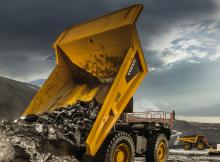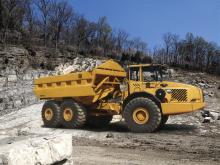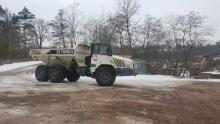The next generation of rigid chassis trucks will be easier to drive and more economical, Mike Woof speculates on the improvements likely to be offered
With the
Engine emissions will be a point of focus, with manufacturers now able to select the Tier 2/Stage II compliant diesels that have been developed for the high power segment. While these engines have been primarily developed to meet North American regulations, the technology is available and the cost implications are not excessive for the customer so it seems likely that they will be offered as standard on trucks built for the European market and in anticipation of future legislation.
The fact that the Tier 2/Stage II compliant engines also offer better fuel consumption is likely to be an additional hook for quarry customers, given recent concerns over fuel prices. Further sophistication in terms of improved electronic control systems will allow better integration of engines and drivelines, further increasing working efficiency for the latest models.
Perhaps the most visual changes will be in the cab and this has been identified as a target area for improvement by manufacturers. With a shortage of qualified operators in many countries, the industry is trying to tempt a new generation into the cab by offering vastly improved levels of comfort and upgraded ergonomics.
These new machines should also prove easier to operate than before and drivers can work for a full working shift without becoming as tired, boosting productivity and safety. The wider sightlines and larger mirrors ensure the operator has a better field of view, while CCTV equipment is fitted to the rear of vehicles for some markets (such as the UK), making reversing up to a dump point considerably easier too.
In terms of design, Caterpillar's F-Series has set design precedents. An innovative feature of the F-Series has been the relocation of the driver's position. Instead of having the driver situated as close to the left of the truck as possible so as to maximise visibility along the side of the machine, the firm has moved the operator seat inwards and towards the centreline. While this configuration is contrary to conventional rigid chassis truck design, the rationale behind the revised layout is that having the driver as close as possible to the machine's centreline will minimise vibration experienced by the operator as the truck passes over uneven terrain. This borrows from design practice in the ADT sector where cabs are centrally-mounted and echoes Caterpillar's revamp of its articulated truck range with the launch of the present 700 series models. It is worth noting that although the cabs are moved inwards, all-round visibility from the F-Series trucks is good, thanks to larger mirrors.
As it will be just three years since the first F-Series models came to market, it seems unlikely that Caterpillar will be presenting radically revamped truck designs aimed at the quarry market. Minor upgrades may be available, while the firm may also opt to add some of its innovative electronic or GPS packages already offered in other equipment ranges.
Another important point in maximising operator comfort and cutting fatigue is the quality of the ride. In this respect, Komatsu's sophisticated suspension system has been among the leaders in the field for some time and it looks likely that the company will continue to refine the technology, with other manufacturers offering similar packages. Komatsu has given customers the choice of two systems in the past, a standard package and adjustable suspension that can be adapted to the running conditions. Given the benefits of the latter option, Komatsu may well choose to make this standard across its quarry-sized rigid truck range in future.
Another important factor for vehicle safety comes in the shape of the braking and retardation packages offered by manufacturers. Oil-immersed disc brakes are now widely available in the quarry truck market and offer major benefits over the earlier dry disc or drum brakes. Fully-enclosed disc brakes require considerably less maintenance while delivering better braking capabilities and the latest systems have a longer service life than previous designs.
Traction control systems, originally offered on high-end passenger cars, are also being offered on quarry trucks at the rear drive tyres. Clearly, these offer safety benefits as they mean the trucks are less likely to lose traction on one side on a slippery or steep ramp haul. However, this feature also makes a major impact on a site's running costs, by reducing tyre wear on each individual truck and cutting the damage to the haul road, which helps productivity and helps reduce wear and tear right across the haul truck fleet. Transmission retardation systems help prevent engine over-speeding, as well as maximising safety on down-grades and the newest machines will most likely see further developments of this technology.
Multi-mode retardation, in which the truck's on-board computer determines the site conditions and operating parameters and then sets the system accordingly, will offer advantages for the driver and customer. Old-style retardation systems acting on the rear wheels only are likely to be superseded, with all-wheel retardation becoming the norm. This is an important safety move as with the older systems it is perfectly feasible for the rear wheels to be moving more slowly than those at the front and in wet conditions this can result in truck drivers having to use opposite lock steering techniques on corners.
There is a 'trickledown' effect with technology from the mining sector slowly but surely moving into the quarrying industry. Sophisticated and costly machine simulators intended to help with operator training and safety issues were originally developed for the surface mining industry and simpler and less expensive versions are now being developed for the quarrying sector.
The benefit for the customer from using machine simulators is substantial. By employing a simulator, a quarry does not have to take a working machine out of service for training operations, reducing the impact on production. Instructors can teach ways of dealing with an array of potentially dangerous situations such as engine or tyre fires, slippery haul roads or retarder/brake failures, without risk.
The use of sophisticated GPS technology on haul trucks is now widespread in the mining sector and is likely to be available for the quarry market in the near future too. This technology allows trucks to be scheduled more effectively, ensuring that they do not have to wait behind another vehicle at a loading area or that loading machines are not idling as they wait for trucks. The software to control truck scheduling can be complex and costly but once again, simpler systems are in development to meet the needs of the quarrying sector.
The technology can also be used to provide a more consistent grade of material into the crushing cycle. For quarries producing the raw materials for cement, this is of particular importance and it means that trucks can be loaded with different grades of materials from different parts of the site to deliver a more homogenous blend.
Overall, much of the technology coming into the quarry truck market already exists, however it will be interesting to see which systems manufacturers opt to offer in the attempt to gain the competitive edge over their rivals.









